This first example shows the most common way to state dialogue. You identify the speaker (explanatory text), then write the words that were said (dialogue).

Now and then you can reverse the order to give variety to your story.
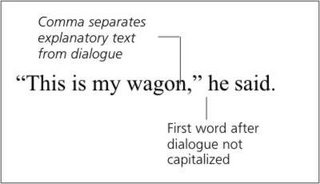
Another way to add variety is to put the explanatory text in the middle of the dialogue.
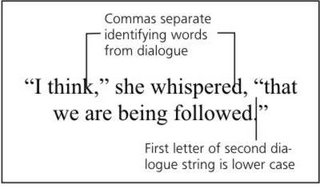
Things become more complex when you quote somebody who is telling you what a third person said. This involves two sets of quotation marks, standard double ones, with single ones inside. In British usage, these two quotation mark customs are reversed. In Britain, single quotations marks are standard for general use, and double ones are used for the inside quotation.
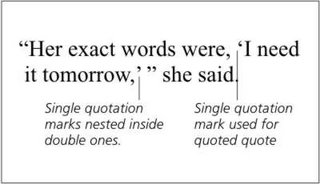
Little changes when the quotation is a question or exclamation. Use the appropriate ending punctuation, always inside the ending quotation mark.
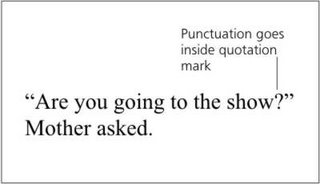
The last example is for those times when you talk to yourself in your stories. If you actually spoke aloud, you could punctuate it with quotation marks. But if you are using thoughts as a form of dialogue, you have two choices. You can put the contents of the thought in italics to set it off, or you can leave it plain. Until recently, standard usage was to leave it plain. That is a remnant of typewriter days when italics were not an option. Today usage is swinging quickly toward the use of italics. Punctuate as usual, just don't use punctuation marks.
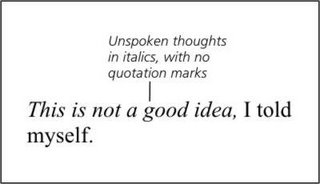
This explanation has covered only dialogue. Quotation marks are also used to set off irony, some titles, unfamiliar words you are using for the first time, and words you are defining. Many people also use them to give emphasis to words. This latter usage is not technically pure, but if you don't overdo it, the Grammar Police will leave you alone.
According to the Grammar Police, any time you use quotation marks, all ending punctuation is always placed inside the final quotation mark. Being the rebellious and free spirit that I am, when it simply doesn't look right and make sense to follow that dictate, I say, “Rules are made to be broken.” Let common usage begin to drive rule creep. I'm not advocating punctuation riots and chaos here, but let reason and good judgement prevail.
And that, Gentle Readers, is all there is to it. Now, how about writing a story with some dialogue in it to give those cool illustrations a reason for being?
Write on,
Sharon Lippincott, aka Ritergal



No comments:
Post a Comment